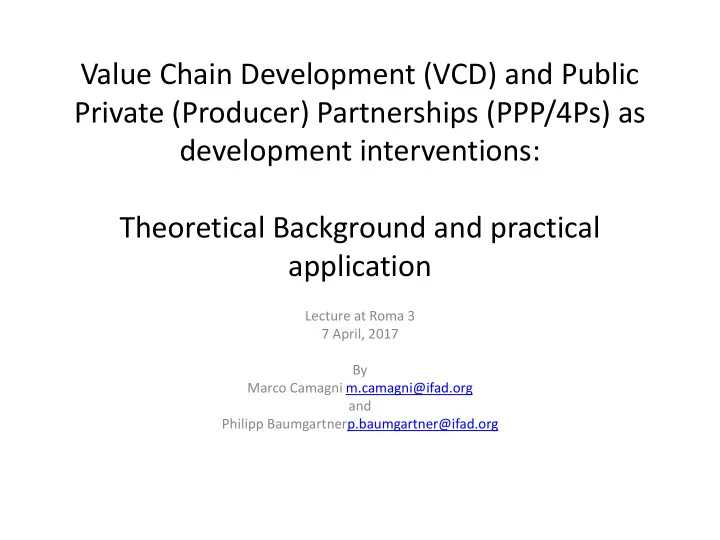

Value Chain Development (VCD) and Public Private (Producer) Partnerships (PPP/4Ps) as development interventions: Theoretical Background and practical application Lecture at Roma 3 7 April, 2017 By Marco Camagni m.camagni@ifad.org and Philipp Baumgartnerp.baumgartner@ifad.org
Ideal flow of our lecture Feedback & Concept of 4Ps Conceptual Experiences Wrap-up in IFAD Theory approach VCD Some Activity 1 VCD in an Pausa Game? Q&A classics IFAD view 15min 50min Discussion 10min 20min Feed-back Practical examples from IFAD work 20min Philipp Baumgartner Marco Camagni
Objectives of the lecture 1. Food system and rural transformation in 21 st century: what role/strategy for smallholder / rural poor? 2. Understand what is VC Approach/ VCD : a systemic view 3. Practical experience from IFAD operations: strengths and weaknesses 4. PPP/ 4Ps as mechanism in VCD My agenda: – excite you about complexity of rural development; – give some theoretical entry points for research; – explain a bit about IFADs work; – answer you questions
Theoretical Background: some core discussions relevant for the VC approach/ PPPs Rural Households as unit of observation Economics of “Small - holder agriculture” Context of todays agricultural system Link between farm and non-farm economy Partial specialisation and coordination
Question: What livelihood activities does a smallholder in a developing country / middle income country follow to earn his living/ feed his family? How does this change over time and as a country’s economy shifts away from agriculture? (as we have seen in many places of the world)
Question: Why would market-access play a role to foster livelihoods of the poor? How does Value Chain Development fit into this? (what is it actually) How does a Public-Private-Producer-Partnerhsip fit in?
SOME CONCEPTUAL BACKGROUND
Rural household: multiple incomes • HLPE 2013; p24 Multiple income streams of a rural household: system approach
Poor work in different livelihood segments (2007 – overview)
FAO 2015: SOFA p7
IFAD 2016 Rural Development Report
Link between rural transformation and poverty reduction IFAD 2016 Rural Development Report
High vs. Low potential rural areas Wiggins and Keaton (2013) p13
High vs. Low potential rural areas • P13 Non-farm matters even in high-potential areas
Most low-pay jobs/self-employment are in the informal sector
IDS 2016 (forthcoming) Informality and inclusive green growth
Link between agr. and ind. labour Dynamic model by Lewis (1954): – Assumption : unlimited supply of labour (high population growth) – Thus: marginal productivity of additional workers in subsistence negligible – But: capitalist sector (plantation/ manufacturing) absorbs surplus labour – Wage = earning on family farm + bonus (~30%) Link between population growth & rural transition Resource endowment matters! (Land/Labour ration)
Farmsize of “small - holders” • What size is small? • HLPE 2013 p27
Where do we move? • HLPE 2013 p29
Where do we move? • HLPE 2013 p29
Deininger & Beyerly 2011 p707 • Question: what pushed what?
• Poulton et al 2010 p1414 Function of and access to markets plays a major role! Access to finance replace labour with mechanisation: function of opportunity costs of labour Technological change affects “optimal farm size” in given labour/capital ratio (e.g. India)
Hence: transformation question What shall a smallholder do: • Grow (scale & productivity)? • Diversify (on- and off-farm)? • Exit (off-farm/industry)?
Task: Work with 2 of your neighbours: Please organise this value chain flow chart.
Value chain actors, functions and specialisation Source: CTA (2012) rethinking the rice Value Chain
USAID – microlinks methodology (webpage)
Interim Conclusion(s): what have you learnt so far? • Rural poor have multiple income streams/ livelihood activities • “Small” is relative and changing • Optimal farm size is driven by population density and technology (comparative advantage) • 3 options for smallholders: grow, diversify or exit • Value Chains are systems with multiple functions and actors
Questions & Reactions
The (simplified) IFAD Project Cycle Project Project Design Implementation (ca 1,5 yrs) (ca 7 yrs)
Design of VC projects
Interested in some examples?
IFAD programme in Malawi: with a focus on VC projects WELCOME Picture: Farmer Business School
Value Chain approach in RLEEP • RLEEP was the first national Value Chain Project in Malawi • 3 components 1) Enabling environment : stakeholder platforms; training of government & service providers; studies 2) Strengthening Value Chain actors : capacity building of various VC actors (producers, input suppliers, traders/processors) 3) Infrastructure : Investing in supporting infrastructure (warehouses, bridges, milk cooling centres, etc.)
Evolution of VC development approach within RLEEP 1 st Phase: 2 nd Phase: 3 rd Phase: Planning based on Extension based on Private-sector led Analysis and consultation and selection process Mapping first experiences (market-pull) • Economy wide mapping of • Consultation with key • Private-sector led commodities stakeholders to identify 2 approach • Selection of 2 VCs additional VCs • Call for proposal to • Selection of 2 further national private sector • in-depth VC studies for VCs • Selection of 3 new VCs 2 commodities to design • Activities based on activities • Private-sector leads consultations and implementation proposals received
Extension modalities in Malawi Government- Private sector Community driven models: led led model: extension: Farmer Business Community animal Community seed Artificial Schools (FBS): health workers : revolving funds : insemination farmers trained groups of para-vets Training of lead groups get seed- agents : Visit each week; each trained by project farmers by capital to by seeds, farmers and are farmer trains 10 to (Heifer government staff and grow the paid by private 20 fellow farmers International); get at village level amount through sector (beef the same paid for services revolving fund producer) who (a, b) week/following and finance drugs (access to input) wants to have high days (multiplier from revolving (a, b) quality supply; (a) effect); (a) funds (a) Incentives for Extension service provider(s): Incentives: mostly Incentive: Project codes: Private incentives based on government for extension agent a – RLEEP recognition (social support (cash) b – SAPP capital)
Shaping the enabling environment: National Platform for Roots and Tubers
Thank You
Recommend
More recommend